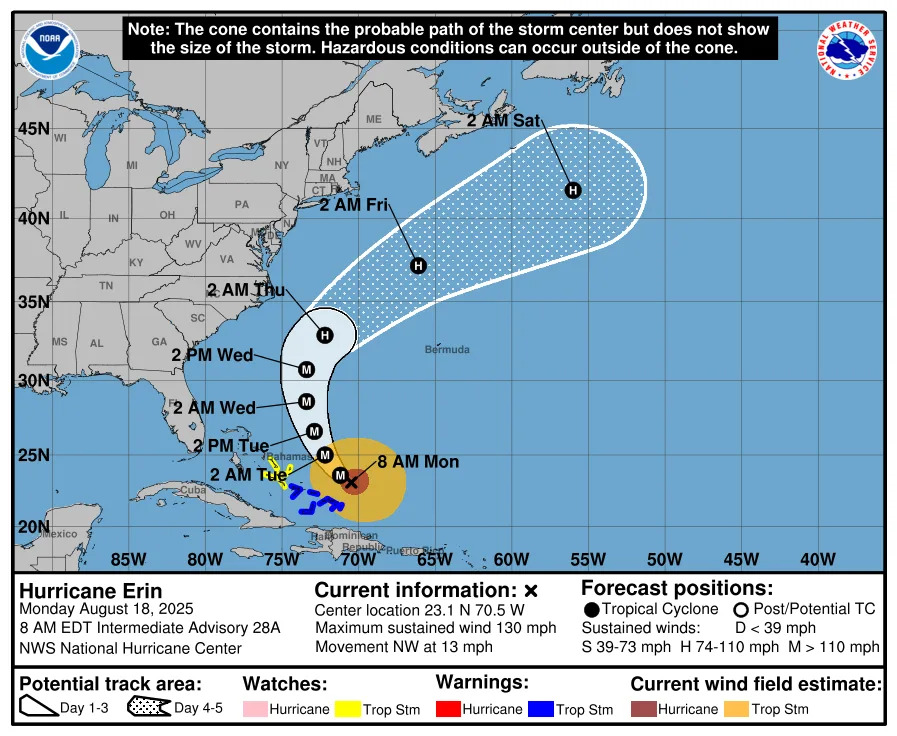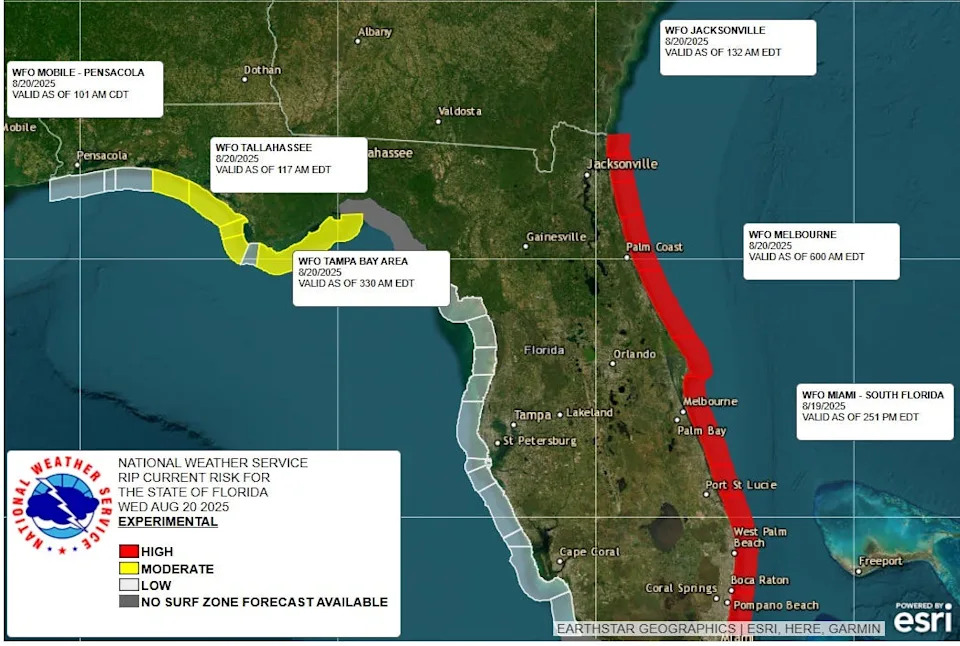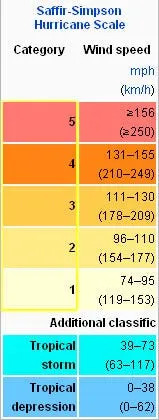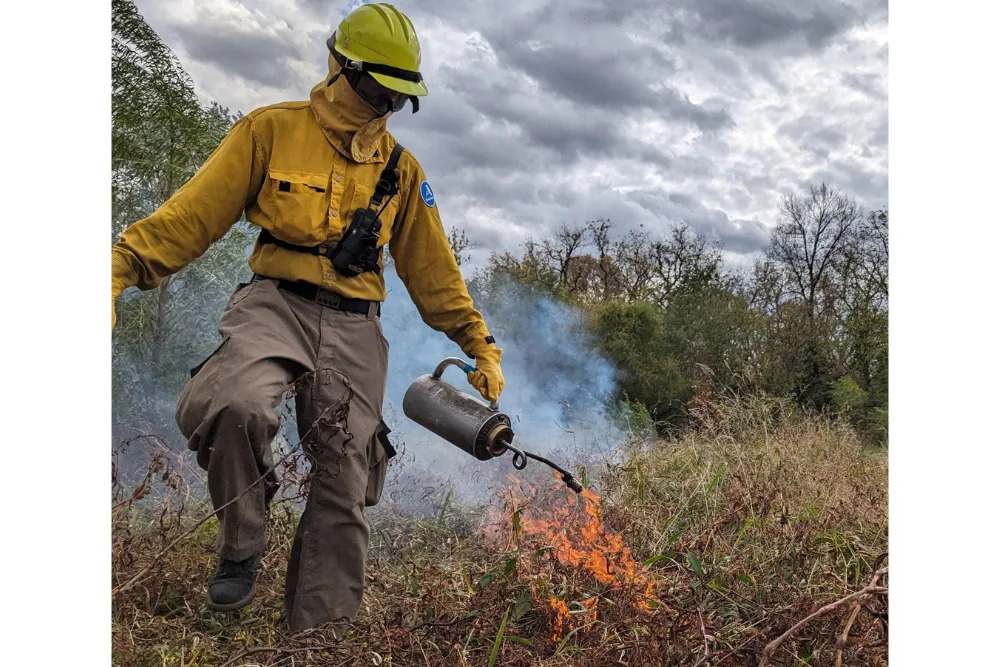In a rush? Get an abbreviated, text view of what's happening with Hurricane Erin.
Outer bands from Hurricane Erin are expected to bring worsening conditions to the coast of North Carolina by this evening, according to the latest advisory from the National Hurricane Center.
The Category 2 storm is continuing to move north-northwest and the center was located about 444 miles east of Daytona Beach at 8 a.m.
➤Hurricane Erin to bring 'powerful' 20-foot waves along East Coast
➤ Weather alerts via text: Sign up to get updates about current storms and weather events by location
The National Weather Service in Melbourne warned large swells from Erin will peak across Florida waters today, bringing large breaking waves and a high risk for deadly rip currents. Waves could reach 6 to 10 feet.
"Stay out of the ocean," the National Weather Service Jacksonville warned, saying waves along the Northeast Florida coast could reach up to 11 feet.
Hurricane Erin projected path. See current location

Special note on the NHC cone: The forecast track shows the most likely path of the center of the storm. It does not illustrate the full width of the storm or its impacts, and the center of the storm is likely to travel outside the cone up to 33% of the time.
Location: 560 miles west-southwest of Bermuda; 400 miles south-southeast of Cape Hatteras, North Carolina; and 444 miles east of Daytona Beach
Maximum sustained winds: 100 mph
Movement: north-northwest at 13 mph
Pressure: 948 mb
Next advisory: 11 a.m. ET
North Carolina braces for Hurricane Erin. See watches, warnings
The National Hurricane Center said weather conditions are expected to deteriorate along the coast of North Carolina by tonight as outer bands from Erin approach.
The National Weather Service in Morehead City, North Carolina, said coastal impacts began overnight along the Outer Banks and will worsen throughout the day. Storm surge of 3 feet or greater is expected above ground level and there's a potential for Highway 12 on Hatteras and Ocracoke Islands "to be impassable and/or inaccessible through late week due to significant wave run up.
"Numerous roads will likely be impassable under several feet of water and vehicles will likely be submerged. Consider moving cars to higher ground."
Several watches associated with Erin have been issued for North Carolina:
Storm surge warning: Cape Lookout to Duck, North Carolina
Tropical storm warning: Beaufort Inlet, North Carolina to the North Carolina/Virginia border, including Pamlico and Albemarle sounds.
Tropical storm watch: North of the North Carolina/Virginia border to Chincoteague, Virginia
➤ NC 12 may be 'impassable' for days due to Hurricane Erin over wash. See evacuation routes
See peak storm surge forecast from Hurricane Erin
Spaghetti models for Hurricane Erin. See projected path
Special note about spaghetti models: Illustrations include an array of forecast tools and models, and not all are created equal. The hurricane center uses only the top four or five highest performing models to help make its forecasts.
Is there a hurricane coming to Florida?
No.
Erin is expected to remain off Florida's coast but it is forecast to bring life-threatening surf and dangerous rip currents from Florida to Canada.
What impacts is Hurricane Erin having on Florida?

Ocean swells associated with Hurricane Erin are expected to bring large ocean swells and life-threatening rip currents to Florida's coast.
Wave heights could reach up to 11 feet along Northeast Florida beaches. Expect rough, high surf through Aug. 21, the National Weather Service Jacksonville posted on X. Minor coastal flooding is possible near high tide.
Along east central Florida beaches, breaking waves could reach 6 to 10 feet, according to the National Weather Service Melbourne.
How strong is Hurricane Erin and where could it go?
At 8 a.m., the eye of Hurricane Erin was located by an Air Force Hurricane Hunter plane near latitude 29.6 North, longitude 73.7 West.
Erin is moving toward the north-northwest near 13 mph. A turn toward the north and north-northeast is expected today and tonight, followed by a faster motion toward the northeast and east-northeast by Thursday and Friday.
On the forecast track, the center of Erin will move over the western Atlantic between the U.S. east coast and Bermuda today through early Friday, and then pass south of Atlantic Canada Friday and Saturday.
Maximum sustained winds are near 100 mph, with higher gusts.
Some strengthening is possible during the next day or so. Weakening is likely to begin by Friday, but Erin is forecast to remain a hurricane into the weekend.
Erin is a large hurricane. Hurricane-force winds extend outward up to 90 miles from the center and tropical-storm-force winds extend outward up to 265 miles.
Watches and warnings issued for Hurricane Erin
A storm surge warning is in effect for:
Cape Lookout to Duck, North Carolina
A tropical storm warning is in effect for:
Beaufort Inlet, North Carolina to the North Carolina/Virginia border, including Pamlico and Albemarle sounds
A tropical storm watch is in effect for:
North of the North Carolina/Virginia border to Chincoteague, Virginia
Bermuda
Hazards affecting land from Hurricane Erin
Wind: Tropical storm conditions are expected over portions of the North Carolina Outer Banks beginning late today or tonight. Tropical storm conditions are possible along the Atlantic coast of Virginia on Thursday and on Bermuda Thursday and Friday.
Surf: Swells generated by Erin will affect the Bahamas, Bermuda, the east coast of the United States, and Atlantic Canada during the next several days. These rough ocean conditions are expected to cause life-threatening surf and rip currents.
Storm surge: The combination of a dangerous storm surge and the tide will cause normally dry areas near the coast to be flooded by rising waters moving inland from the shoreline. The water could reach the following heights above ground somewhere in the indicated areas if the peak surge occurs at the time of high tide:
Cape Lookout to Duck, North Carolina: 2 to 4 feet
The deepest water will occur along the immediate coast where the surge will be accompanied by large and dangerous waves. Surge-related flooding depends on the relative timing of the surge and the tidal cycle, and can vary greatly over short distances.
Rainfall: The outer bands of Erin may bring 1 to 2 inches of rainfall to the Outer Banks of North Carolina this afternoon into Thursday.
Key messages from the National Hurricane Center: What you need to know about Hurricane Erin
Erin is expected to produce life-threatening surf and rip currents along the beaches of the Bahamas, much of the east coast of the U.S., Bermuda, and Atlantic Canada during the next several days. Beachgoers in those areas should follow advice from lifeguards, local authorities, and beach warning flags.
Storm surge flooding and tropical storm conditions are expected in the North Carolina Outer Banks beginning later today or tonight. The storm surge will be accompanied by large waves, leading to significant beach erosion and overwash, making some roads impassible. Tropical storm conditions are possible on Thursday along the southeastern coast of Virginia.
Tropical storm conditions are possible on Bermuda on Thursday and Friday.
Interests elsewhere along the U.S. Mid-Atlantic and southern New England coasts, and Atlantic Canada, should also monitor the progress of Erin as strong winds are possible Thursday through Saturday.
Current forecast: How strong could Hurricane Erin get?
At 5 a.m.: 100 mph
12 hours: 105 mph
24 hours: 110 mph
36 hours: 110 mph
48 hours: 105 mph
60 hours: 100 mph
72 hours: 85 mph
96 hours: 75 mph; post-tropical, extratropical
120 hours: 65 mph; post-tropical, extratropical
Hurricane categories: Saffir-Simpson Hurricane Wind Scale

Category 1 hurricane: 74-95 mph
Category 2 hurricane: 96-110 mph
Category 3 hurricane: 111-129 mph
Category 4 hurricane: 130-156 mph
Category 5 hurricane: 157 mph or higher
Stay informed. Get weather alerts via text
What's next?
We will update our tropical weather coverage daily.
Download your local site's app to ensure you're always connected to the news. And look for our special subscription offers here.
This story has been updated to include new information.
This article originally appeared on Treasure Coast Newspapers: Hurricane Erin projected path, Florida impacts






Comments